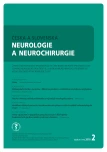Patients with idiopathic REM sleep behavior disorder follow-up – phenoconversion into parkinsonian syndrome and dementia
Authors:
P. Peřinová 1; L. Plchová 1; J. Bušková 1,2; D. Kemlink 1; V. Ibarburu Lorenzo Y Losada 1; S. Dostálová 1; T. Vorlová 1; K. Šonka 1
Authors‘ workplace:
Centrum pro poruchy spánku a bdění, Neurologická klinika a Centrum klinických neurověd 1. LF UK a VFN v Praze
1; Oddělení spánkové medicíny, Národní ústav duševního zdraví, Klecany a 3. LF UK, Praha
2
Published in:
Cesk Slov Neurol N 2018; 81(2): 205-207
Category:
Short Communication
doi:
https://doi.org/10.14735/amcsnn2018205
Overview
Background and aim:
Idiopathic REM sleep behavior disorder (iRBD) is regarded as the initial stage of neurodegenerative diseases, especially synucleinopathies. The aim of this study was to evaluate the phenoconversion into parkinsonian syndrome and dementia in patients diagnosed with iRBD.
Methods:
This is a retrospective study comprising of patients diagnosed with iRBD prior to 2015 at the Centre for Sleep and Wake Disorders, Department of Neurology, First Faculty of Medicine, Charles University and General University Hospital in Prague. Conversion was explored from medical documentation of neurologically followed-up patients and structured interview, as well as using information provided by general practitioners. We were able to assess the development in 34 of these patients (26 males, 8 females).
Results:
The median age of iRBD symptom onset was 62 (41– 83) years, the median age at iRBD diagnosis was 67 (46– 83) years and the median follow-up was 5 (1– 14) years. Eleven (32.4%) patients displayed symptoms indicating phenoconversion into the following subgroups: Parkinson’s disease (four patients), Lewy body dementia (three patients), multiple system atrophy (one patient) and dementia which was not further specified (three patients). Four patients displaying mild extrapyramidal symptoms did not meet Parkinsonian syndrome criteria. The ratio of patients who developed a defined neurodegenerative disease within 5 years from the iRBD symptom onset was 20.6% (95% CI 10.4– 36.8%). The median latency of phenoconversion patients with conversion was 5 (1– 27) years.
Conclusion:
The iRBD phenoconversion in our patient population is similar to that of other studied cohorts, suggesting that also in the Central European predominantly Slavic population, iRBD can be considered as the initial stage of neurodegeneration with pathological alpha synuclein deposition.
Key words:
REM sleep behavior disorder – neurodegeneration – synucleinopathy
The authors declare they have no potential conflicts of interest concerning drugs, products, or services used in the study.
The Editorial Board declares that the manuscript met the ICMJE “uniform requirements” for biomedical papers.
Sources
1. American Academy of Sleep Medicine. International Classification of Sleep Disorders. 3rd ed. Darien, USA: American Academy of Sleep Medicine 2014.
2. Boeve BF, Silber MH, Saper CB et al. Pathophysiology of REM sleep behaviour disorder and relevance to neurodegenerative disease. Brain 2007; 130(11): 2770– 2788. doi: 10.1093/ brain/ awm056.
3. Pujol M, Pujol J, Alonso T et al. Idiopathic REM sleep behavior disorder in the elderly Spanish community: a primary care center study with a two-stage design using video-polysomnography. Sleep Med 2017; 40: 116– 121. doi: 10.1016/ j.sleep.2017.07.021.
4. Kang SH, Yoon IY, Lee SD et al. REM sleep behavior disorder in the Korean elderly population: prevalence and clinical characteristics. Sleep 2013; 36(8): 1147– 1152. doi: 10.5665/ sleep.2874.
5. Iranzo A, Molinuevo JL, Santamaría J. Rapid-eye-movement sleep behaviour disorder as an early marker for a neurodegenerative disorder: a descriptive study. Lancet Neurol 2006; 5(7): 572–577. doi: 10.1016/ S1474-4422(06)70476-8.
6. Schenck CH, Boeve BF, Mahowald MW. Delayed emergence of a parkinsonian disorder or dementia in 81% of older men initially diagnosed with idiopathic rapid eye movement sleep behavior disorder: a 16-year update on a previously reported series. Sleep Med 2013; 14(8): 744– 748. doi: 10.1016/ j.sleep.2012.10.009.
7. Fereshtehnejad SM, Montplaisir JY, Pelletier A et al. Validation of the MDS research criteria for prodromal Parkinson’s disease: longitudinal assessment in a REM sleep behavior (RBD) cohort. Mov Disord 2017; 32(6): 865– 873. doi: 10.1002/ mds.26989.
8. Iranzo A, Fernández-Arcos A, Tolosa E et al. Neurodegenerative disorder risk in idiopathic REM sleep behavior disorder: Study in 174 Patients. PLoS ONE 2014; 9(2): e89741. doi: 10.1371/ journal.pone.0089741.
9. Postuma RB, Gagnon JF, Montplaisir JY. REM sleep behavior disorder and prodromal neurodegeneration - where are we headed? Tremor Other Hyperkinet Mov (N Y) 2013; 3: pii. doi 10.7916/ D8N879HS.
10. Stefanova N, Wenning GK. Review: Multiple system atrophy: emerging targets for interventional therapies. Neuropathol Appl Neurobiol 2016; 42(1): 20– 32. doi: 10.1111/ nan.12304.
11. Hao C, Wang W, Wang S et al. An overview of the protective effects of chitosan and acetylated chitosan oligosaccharides against neuronal disorders. Marine Drugs 2017; 15(4): 89. doi: 10.3390/ md15040089.
Labels
Paediatric neurology Neurosurgery NeurologyArticle was published in
Czech and Slovak Neurology and Neurosurgery

2018 Issue 2
- Metamizole vs. Tramadol in Postoperative Analgesia
- Memantine in Dementia Therapy – Current Findings and Possible Future Applications
- Memantine Eases Daily Life for Patients and Caregivers
- Metamizole at a Glance and in Practice – Effective Non-Opioid Analgesic for All Ages
- Advances in the Treatment of Myasthenia Gravis on the Horizon
Most read in this issue
- Ataxia
- Brain biopsy in 10 key points – what can a neurologist expect from the neurosurgeon and the neuropathologist?
- Fabry disease, an overview and the most common neurological manifestations
- Glucose transporter-1 deficiency syndrome – expanding the clinical spectrum of a treatable disorder
